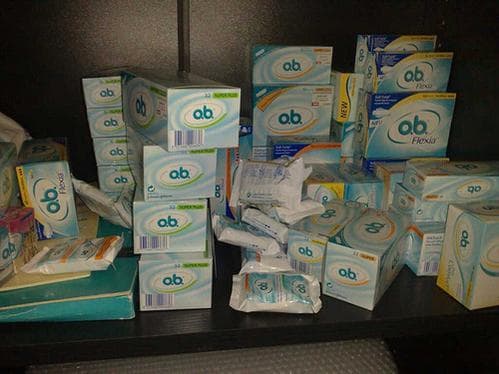Advertisement
Toxic Shock Expert On O.B. Tampon Shortage

I checked back in with Johnson & Johnson spokeswoman Bonnie Jacobs this week to ask if she had any news on the o.b. tampon shortage. No, she messaged: "I don't have any updates to the information I provided." (See her previous statement here; she cites a "supply interruption" and says that the decision to discontinue the Ultra size was not based on any adverse events.)
All well and good, but frustrated reports of empty o.b. shelves continue to roll in to CommonHealth from as far away as Iceland, and to be honest, I'm now just ragingly curious. Why can Johnson & Johnson not just tell their clamoring would-be customers exactly what went wrong with o.b. production? And why not disclose their reasons for doing away with the Ultra, which has long been a mainstay for women with heavy periods?
One theory bandied about in our comments is that perhaps the Ultras, or o.b.s in general, have been linked to recent cases of toxic shock, a rare but potentially deadly syndrome that can be triggered by tampon use. To check on that, I spoke today with the microbiologist known for helping to crack the mystery of toxic shock syndrome back in the 1980s.
Dr. Philip M. Tierno Jr. is director of clinical microbiology and immunology at New York University Langone Medical Center, and author of the "The Secret Life of Germs." He has been involved in work on toxic shock syndrome for thirty years, and speaking with him for just a few minutes is enough to convert any tampon-user to the all-cotton products sold in health food stores. Or pads. Or cups. The point is, toxic shock, though rare, still happens. Young women still die, or need limbs amputated, he said.
But first, the o.b. question. I laid out the picture of the shortage, including J&J's report of supply interruptions, and asked what light he could shed.
"I have no idea what their production problem is," Dr. Tierno said. "Certainly there is some sort of production problem, that’s clear. I know that tampons are made primarily of viscose rayon; sometimes they may have mixes of cotton. And what I know is that the Chinese and other producers of cotton have had difficulty with crops. So this may play some role, if they’re mixing with a specific amount. And the only other thing I can tell you is that all of the extant tampons on the [mainstream] market are made with the synthetic ingredient viscose rayon, in mixes with or without cotton, and all of these extant tampons are able to produce TSST1 toxin [which has been implicated in toxic shock syndrome]. In my studies I have clearly shown that, albeit viscose rayon is the best of the bad four ingredients in tampons and the other three have been removed, this still remains, and toxic shock still occurs in this country, and deaths also occur in this country."
[See this story on a 20-year-old Indiana woman who died of toxic shock syndrome this summer.]
How many people are dying? I asked. A handful a year?
Reporting toxic shock deaths to the CDC is not required, he said, so the numbers are not very accurate. But tampon box warnings say that between 1 and 17 of every 100,000 girls and women using tampons get toxic shock syndrome. [My thought: Rare, yes, but there are tens of millions of menstruating women in this country.]
And are tampons meant for heavier flow, like the Ultra, likelier to cause it?
In the past, he said, absorbency and size did matter, "but it's more the composition that matters. Even the regular size can cause toxic shock. And we've had slender regulars cause toxic shock when they’re made of viscose rayon. I know of no case, none, of people who use 100% cotton who had toxic shock syndrome."
It's expensive, he said, and cotton is a crop subject to the vagaries of nature, but companies do make 100% cotton tampons.
Does he recommend 100% cotton tampons, then?
"Without question," he said. "Shift to all cotton. And if you're too young, don't use tampons. [Young women are more susceptible to toxic shock because they're less likely to have the antibodies to fight it.] And if you use tampons, never use them at night." [Additional advice from health authorities: Never leave a tampon in for more than eight hours. Some Web MD basics on prevention are here.]
"People are dying," he said. And "it's not only the dead, it's those young kids who have amputations of various limbs, and toes and hands and legs. It's not just death."
So might the o.b. Ultra, or o.b.s in general, have been implicated in cases of toxic shock lately?
If they had been, Dr. Tierno said, he would not expect the manufacturers to admit it. That would be "admitting guilt."
Not to end on so sinister a note, one recent CommonHealth commenter had this to say:
"The reason they have discontinued the OB Ultra's is simply MONEY! If we cannot get our Ultra's, we'll have to use the next size down. As those will last an hour or less, we'll consume more and they will profit more."
This program aired on January 7, 2011. The audio for this program is not available.
